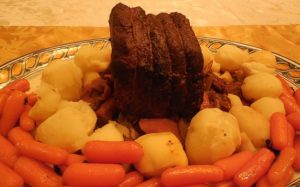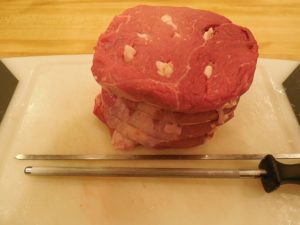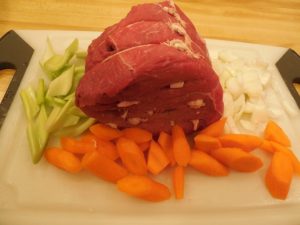Italian Pot Roast in Barolo Wine for Sunday Dinner
Italian Pot Roast in Barolo Wine
The most moist and flavorful pot roast is Italian—and easy to make! Try it for a special Sunday dinner.
Try Italian Pot Roast in Barolo Wine for YOUR Sunday Dinner!
“Do Italians really make pot roast?” I am happy to share not only that Italians do make pot roast, but also that Italian-style pot roast is the most moist and flavorful pot roast I’ve ever tasted!
When I lived in San Francisco, I discovered the wonderful way that Northern Italians from the Lombardy region have with pot roast. They braise their pot roast slowly, under low heat for many hours, with a full-bodied northern Italian red wine called Barolo wine. With this method, the meat becomes melt-in-your-mouth soft and delicious. If you can’t find the Barolo wine that is typical of Northern Italy, Barbera wine or any hearty Italian red wine will do.
I’ve been making Italian pot roast in red wine for many years now, usually as a special treat for Sunday dinners with my family. The nice thing about the Italian red wine method is that the meat is even more flavorful if reheated; with this in mind, the dish is traditionally prepared the day before serving. Cook the meat until it is almost done, then reheat and finish in about an hour’s time for your special dinner the next day. And don’t worry—there is virtually no way to overcook pot roast with this method!
For the Italian pot roast recipe below, you will need a 3 lb. top round or rump round cut of beef. Ask your butcher to tie your meat with butcher’s twine, so the roast will stay intact as it cooks. Or, if you’d like to try to tie the meat yourself, click on the link to a master chef’s video from Le Cordon Bleu.
The recipe below also calls for “larding” the meat. This is an old method, whereby salt pork is inserted into tough cuts of meat to yield more tenderness and flavor. Nowadays, salt pork can be hard to find. And although larding is not absolutely necessary, I find that when I use a minimally processed bacon fat—no smoke, salt, or other flavorings added—this little bit of added fat does seem to help keep the roast moist during the long braising time. I have provided below a simple method for larding meat with kitchen utensils found in most homes. If you are interested in a special larding gadget and watching the larding process in real time, click on this video: Tescoma Presto Larding Needle.
Of course, you may add a vegetable side dish (contorno) to your pot roast meal. Northern Italy is the home of polenta, which would make a wonderful accompaniment. Small boiled potatoes and cut carrots are also nice to frame your roast when you present it on a serving dish.
And don’t throw away the vegetables that have been braising with the roast—those onions, carrots, and celery may have an unappealing brownish color, but they will also have developed a wonderful sweetness. Serve as a garnish to top the pot roast slices when they are plated. Ladle the finished slices with the warm pot roast juices and enjoy! —Kathryn Occhipinti

Ingredients
for the Pot Roast:
1 (3 lb.) top round of beef, tied with butcher’s twine
6 strips natural, uncured, unsalted bacon
1 or 2 large cloves of garlic,
with the second clove sliced lengthwise into several thin slices
1/4 cup butter
1/4 cup olive oil
1 whole, dried clove
1 onion, chopped coarsely
3 carrots, sliced diagonally into thick slices
2 stalks of celery, sliced diagonally into thick slices
1 cup Barolo wine, Barbera wine, or any full-bodied Italian red wine
1/4 cup tomato paste
Ingredients
for the Vegetable Garnish
1 lb. of small red or yellow potatoes
1 lb. of carrots, cut into serving pieces
Fresh parsley
Method
Prepare the meat and vegetables:
Prepare your top round or rump round meat by rinsing, patting dry, and then tying with butcher’s twine, if the butcher has not already done this for you.

Lard the meat by making holes lengthwise through the roast and then pushing a strip of fat from the bacon through each hole. One of my steel barbecue skewers cuts through the meat nicely and makes a hole about the right size. I use my fingers and, if necessary, my knife sharpener or the dowel of a wooden spoon to push the fat through. A special larding device, of course, does the job easily and quickly (see above for the link).
Rub the meat all over with the garlic. If you like, make additional small cuts with a paring knife and insert small slices of garlic into the meat.

Cut up your vegetables, so all is ready to go before you start to cook.

Cook your pot roast:
Heat the butter and oil together under low heat in a deep, heavy pan. Use an oven-proof pan or pot if you have one. (Or you can transfer to a pot suitable for the oven later.)
When the butter has melted, add the pot roast and brown the meat under medium heat, turning the meat with tongs so that each side browns nicely.
After the meat has browned completely, add the clove, onions, carrots, celery, and wine, with 1 cup of water.
If you are making this dish on the stovetop, cover and cook slowly under low to medium heat, so the liquid is kept at a simmer.
-or-
If you have an oven-proof pan, I find it easier to transfer the pan to the oven and cook at 325°. If you do not have an oven-proof pan, you can move the pot roast from the pan into a pot, but be sure to scrape the bottom of the original pan with a wooden spoon so the liquid contains all of the good-tasting browned pieces from the bottom. Then pour the liquid over the pot roast.
The pot roast should cook gently for 3 hours. During that time, every 30 minutes or so, uncover briefly, turn the pot roast gently, and baste it in its juices.
After 3 hours, add the tomato paste diluted in 1/2 cup of water. You may need to add additional water to the pot if some has evaporated and the juices become too thick.
Continue cooking and braising as above for another 2 hours.
The cooking process can be stopped at this time. The meat should be tender enough to flake easily when tested with a fork along one of the corners. If not, continue to cook for an additional hour or so.
When the meat is done cooking, it is traditional to leave the meat in the pot with the juices and cooking vegetables until the next day, then reheat an additional 30 minutes to an hour or so before serving. (Refrigerate the pot roast until ready to cook for this final hour.)
While the pot roast is reheating, prepare your favorite vegetable to go with the meal. Polenta, small potatoes, and boiled or glazed cut carrots look nice surrounding the pot roast, but any favorite vegetable is fine.
Serve your pot roast:

When you are ready to serve, take the pot roast out of its cooking pan and place it in the center of a platter. Remove the twine and cut into slices—before or after presenting at the table.
Strain the pan juices, and reserve the vegetables to place around the pot roast. They will look brown but should still have some shape and will taste very sweet.
Drizzle some of the pan juices over the pot roast and reserve the rest to serve in a gravy boat.
Surround your pot roast with prepared vegetables of your choice for the final presentation. Serve and enjoy!
—Kathryn Occhipinti
Kathryn Occhipinti, MD, is the author of the
Conversational Italian for Travelers series of books and a teacher of Italian for travelers to Italy in the Peoria and Chicago area.
“Everything you need to know to enjoy your visit to Italy!”
Join my Conversational Italian! Facebook group and follow me on Twitter at StellaLucente@travelitalian1 and start to learn Italian today for FREE!
Conversational Italian! Facebook Group
Tweet @travelitalian1 for Stella Lucente Italian
YouTube videos to learn Italian are available from © Stella Lucente, LLC.
Learn Conversational Italian.
More information on and photographs of Italy can be found on Facebook Stella Lucente Italian and Pinterest Stella Lucente Italian.
Facebook Stella Lucente Italian
Pinterest Stella Lucente Italian
Visit learntravelitalian.com/download.html to purchase/download Conversational Italian for Travelers and find more interesting facts and helpful hints about getting around Italy! Learn how to buy train tickets online, how to make international and local telephone calls, and how to decipher Italian coffee names and restaurant menus, all while gaining the basic understanding of Italian that you will need to know to communicate easily and effectively while in Italy. —From the staff at Stella Lucente, LLC
Italian Pot Roast in Barolo Wine



